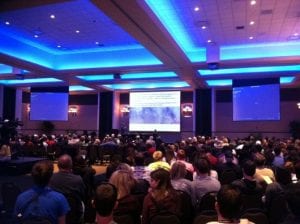Closest-Ever Asteroid Flyby Thrills Large UCF Crowd
 More than 800 people packed the Pegasus Ballroom at the University of Central Florida on Friday to watch a live video feed of an asteroid zip by Earth, coming within 17,500 miles from the planet.
More than 800 people packed the Pegasus Ballroom at the University of Central Florida on Friday to watch a live video feed of an asteroid zip by Earth, coming within 17,500 miles from the planet.
It was the closest flyby on record, with the half-city-block sized asteroid squeezing in between the Earth’s surface and orbiting communication satellites. The crowd cheered when asteroid 2012 DA14 buzzed by and started to depart the planet’s gravitational field again.
The video feed was the highlight of the two-hour program, which captivated students, professors, retirees and children.
Four speakers talked about the odds of getting hit by an asteroid, how NASA could deflect an asteroid on a collision course with Earth, NASA missions planned to return samples from nearby asteroids, and the relationship between asteroids and meteorites.
UCF Physics Professor Dan Britt used humor to explain the difference between asteroids and meteorites – a topic that generated much interest because a meteorite had struck Russia earlier Friday, scattering debris and causing more than 1,000 injuries.
The once-in-a-lifetime event captured international attention as NASA and observatories around the world worked together to capture images and feed them to a hungry Internet audience.
National Public Radio broadcasted live from UCF’s Student Union during its very popular Science Friday segment (http://www.sciencefriday.com/segment/02/15/2013/tracking-a-space-rock-s-streak-past-earth.html ). UCF Professor Humberto Campins, an international expert on asteroids who organized the event, offered commentary to Science Friday’s radio host, and NPR listeners heard cheers from UCF’s crowd during the asteroid’s closest approach.
This flyby represented an excellent opportunity to learn about these mysterious rocks and to help the public understand why they should care about them, Campins said.
In addition to Campins and Britt, speakers included Michael F. A’Hearn, the scientist who led NASA’s Deep Impact mission, which launched the first man-made object into the nucleus of a comet. He spoke about deflecting dangerous asteroids. Harold Reitsema, a planetary scientist who is part of the B612 Foundation’s private effort to launch a telescope that will locate and track asteroids that could hit Earth, talked about why private industry is focusing on asteroids. Ray Lugo, the new director of the Florida Space Institute, moderated the panel discussion.
To help the audience warm up to the science talk, some of UCF’s physics professors and students cooked up edible asteroid and comets. The team used a variety of ingredients, including sugar, ice cream and cookie chunks, to explain how asteroids form. Samples were handed out, and recipes will be posted on the event website shortly due to popular demand.
Organizers at UCF are part of the Planetary Sciences Group in the College of Sciences. The group includes well-respected astronomers with several NASA research grants worth millions of dollars. Professors in the department have been involved a variety of missions from observations of planets via NASA’s Spitzer telescope to such high-profile missions as Stardust, Deep Impact, Pathfinder and the Mars Exploration Rover Mission. UCF also is home to the Robinson Observatory, which is open to the public on a regular basis, and the Florida Space Institute, which supports space research, development, and education activities as well as Florida’s space economy.
For more information, visit www.cos.ucf.edu/asteroid.
